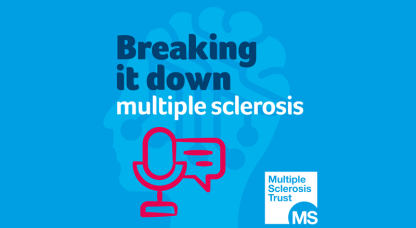Balance problems are common in MS. Virtual reality (VR) balance training has been shown to help improve balance in people who have Parkinson’s disease or who have had a stroke. This study compared VR balance training programme with a conventional balance exercise group to see if it could help improve balance in people with MS.
32 people with relapsing remitting MS took part in the study. Half received virtual reality (VR) balance training and the other half conventional balance exercise.
The study found that following six weeks of training, balance was improved in both groups showing both traditional balance training and VR training can improve balance. In addition to improving balance the VR system training also reduced the fear of having a fall.
Balance problems are common in MS. Lesions in the areas of the brain responsible for movement and balance or in the sense areas and systems can cause problems with balance, which can result in walking difficulties and sometimes falls.
Several different approaches can be tried to improve balance in people with MS including exercise and movement or sensory stimulation programmes. Virtual reality (VR) systems could also be useful. They provide a stimulating environment that can replicate some real world encounters, such as walking on an uneven or sloped surface, and they can provide immediate feedback on performance, helping someone improve their balance in a safe environment.
VR balance training has been shown to help improve balance in people who have Parkinson’s disease or who have had a stroke. A few small studies have investigated if they could help people with MS, and the results were promising, but no study to date had compared VR training with another balance treatment for comparison.
This study aimed to compare a 6-week VR balance training programme with a conventional balance exercise group to see if it could help improve balance in people with MS.
How this study was carried out
32 people with relapsing remitting MS took part in the study. To be included they had to be between 25 and 55 years of age and have an EDSS score of between three and six.
Participants were randomly allocated either receive virtual reality (VR) balance training or conventional balance exercise. For both groups they took part in 30 minute training sessions, twice a week, for six weeks.
In the normal balance control group, each of the 12 training sessions consisted of 10 minutes of stretching exercises and 20 minutes of training. The training was based on a previous programme used in other studies and involved:
- Postural control exercise – participants stood on an unstable foam surface with their eyes open or closed, the surface was made more unstable by adding more pieces making the task harder over time.
- Weight shifting – participants stepping and reaching to catch a ball that a therapist was throwing at them. To increase the difficulty to the task over time different sizes of ball were used and the speed and distance that it was thrown were changed.
- Perturbation exercises – participants stood on a wobble board, which is an unstable surface and tried to maintain their balance while the therapist pushed the top of the board in a downward direction, on different places and at various speeds.
The VR system used in this study is called the CAREN system. It is made up of a motion platform and a projection screen. There are barriers around the platform and the participants are strapped into a safety harness, just in case they do lose their balance. There are pictures of the system in the research paper. The training using the VR system consisted of:
- A road scene which was projected on to the screen – participants had to maintain their balance while moving along the ‘road’, which was bumpy in places, and changed in slope and direction.
- Intercepting moving targets – participants also had to intercept a coloured ball that appeared above the road, these appeared one at a time and were displayed for five seconds and appeared on the left and right.
- The VR training tasks were made more difficult by increasing the speed of the programme and increasing the amount the platform titled by.
Participants were assessed by a qualified physical therapist at the start of the study and at the end. The assessments included several tests such as the Berg Balance Scale, the Four Square Step Test and the Falls Efficiency Scale International. Each participant was also assessed on a specialised treadmill that takes walking measurements, the distribution of weight between the left and right sides and also allows other tests to be performed.
The study found that following six weeks of training, balance was improved in both groups showing both traditional balance training and VR training can improve balance. The participants who had taken part in the VR training also had less fear that they would have a fall.
This study shows that VR training can improve balance in people with MS and reduce their fear of falling. The authors suggest that the VR system has several benefits, including providing realistic environments and as these can be controlled and they have safety features they can help build someone’s confidence in a safe environment. Additionally as the VR system is designed for people with medical conditions it can be used to target areas where someone might be having difficulty, such as with balance.
The researchers conclude that VR training could be used to help improve balance in people with MS, but further research would be needed to see if the balance improvements last over the long term. They suggest that due to the size and cost of such systems the potential for their use is limited to larger medical centres, but they suggest for some it could be a complementary approach to help improve balance.
Kalron A, Fonkatz I, Frid L, et al.
The effect of balance training on postural control in people with multiple sclerosis using the CAREN virtual reality system: a pilot randomized controlled trial.
J Neuroeng Rehabil. 2016 Mar 1;13(1):13. doi: 10.1186/s12984-016-0124-y.
Abstract
Read the full text of this paper
MS can affect balance in a number of ways, both directly and indirectly.
Balance problems can be caused by interruptions to the communication between the brain and the rest of the body. A lesion may mean messages coming to and from the brain from other parts of the body do not get through properly and so the brain cannot process the information correctly as it only has part of the picture. A good example of this is dizziness and vertigo. In MS, these symptoms are caused by damage to areas that coordinate perception and the response to visual and spatial information. The damage causes a breakdown in the coordination, which makes it difficult to remain upright, even when standing still and being supported.
Sensory problems may affect the way in which someone walks and therefore affect their balance. For example, numbness can mean an individual cannot tell how their feet are touching the ground, or pain may mean they walk more tentatively or try not to put too much weight through the painful leg, making them walk in an unstable and unbalanced way.
There are also a number of other MS symptoms which can worsen balance and increase the risk of falling. These include, weakness and numbness, muscle stiffness, spasticity and spasms, tremor, visual problems and fatigue.
Because there are a number of factors which can affect balance, it is important that balance problems are investigated thoroughly by a physiotherapist or other health professional. They can then suggest treatments to improve balance.
Balance problems can be managed to some extent by being aware of factors that make balance worse and being aware of potential factors that might increase the risk of a fall.
View balance exercises for people with MS or order the Move it for MS exercise DVD.


